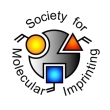Authors: Zulfikar MA, Wahyuningrum D, Mukti RR, Setiyanto H
Article Title: Molecularly imprinted polymers (MIPs): a functional material for removal of humic acid from peat water.
Publication date: 2015
Journal: Desalination and Water Treatment
Page numbers: 1-12.
DOI: 10.1080/19443994.2015.1069218
Abstract: The aim of this study is to investigate the use of moleculary imprinted polymers (MIPs) material as an alternative adsorbent for the adsorption of humic acid (HA) from peat water in batch mode. The MIPs were prepared with methyl methacrylate as a monomer, HA as templates, ethylene glycoldimethacrylate as a cross-linker, and dimethyl formamide as a solvent. The characteristics of MIPs were evaluated using Fourier transform infra-red spectroscopy, scanning electron microscope, and Brunauer-Emmett-Teller methods. The Langmuir, Freundlich, and Sips models were applied to describe the equilibrium isotherms using non-linear regression analysis. Pseudo-first-order, pseudo-second-order, intraparticles, and Boyd kinetic models were used to describe the kinetic data. The results showed that the equilibrium contact time was 60 min. The experimental results indicated that the percentage of sorption increases with an increase in the adsorbent dosage and temperature. The adsorption percentage decreased with increasing peat water pH from 2 to 12. The equilibrium data fitted well for the Langmuir adsorption isotherms, with monolayer adsorption capacity of MIPs found to be 45.45 mg/g. The results of the kinetic study show that the adsorption of HA onto MIPs could be described by the pseudo-second-order kinetic model with a rate constant in the range of 0.034-0.115 g/mg min and controlled by film diffusion, with the effective diffusion coefficient was found in the range of 7.42 x 10-8 - 13.84 x 10-8 cm2/s. Thermodynamic parameters data indicated that under the experimental conditions, the HA adsorption process was non-spontaneous and endothermic, with the Gibbs free energy (Δ G°) in the range of 3.71-1.17 kJ/mol, whereas enthalpy (Δ H°) and entropy (Δ S°) at 16.17 and 42.70 J mol-1, respectively
Author keywords: Adsorption, Humic acid, isotherm, MIPs, Peat water



Join the Society for Molecular Imprinting

New items RSS feed
Sign-up for e-mail updates:
Choose between receiving an occasional newsletter or more frequent e-mail alerts.
Click here to go to the sign-up page.
Is your name elemental or peptidic? Enter your name and find out by clicking either of the buttons below!
Other products you may like:
 MIPdatabase
MIPdatabase









